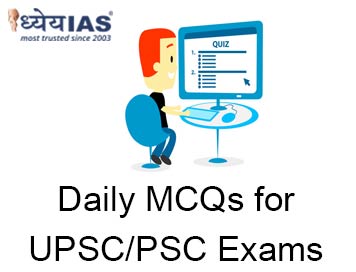Home > Daily-mcqs
Daily-mcqs 21 Aug 2025

Q1:
Assertion (A): India’s participation in Quad limits its ability to engage constructively with China. Options
Reason (R): Quad members are geopolitically aligned against Chinese influence in the Indo-Pacific.
A: Both A and R are true, and R is the correct explanation of A.
B: Both A and R are true, but R is not the correct explanation of A.
C: A is false, but R is true.
D: Both A and R are false.
Answer: A
Explanation:
Both the assertion and reason appear to be true. The Quad's focus on the Indo-Pacific and its members' shared concerns about China's influence in the region do suggest that the grouping is geopolitically aligned against Chinese influence. This alignment could limit India's ability to engage constructively with China, as India's participation in Quad might be seen as part of a containment strategy. Therefore, Both A and R are true, and R is the correct explanation of A.
Q2:
I. It is listed as a Critically Endangered species under the IUCN Red List. How many of the statements given above are correct?With reference to the Saltwater Crocodile (Crocodylus porosus) and its conservation in India, consider the following statements:
II. It is naturally found in both freshwater and marine habitats across India.
III. The Bhagabatpur Crocodile Project is located within the Sundarbans Biosphere Reserve.
IV. The Crocodile Conservation Project (1975) was launched exclusively for the protection of saltwater crocodiles.
A: Only 1
B: Only 2
C: Only 3
D: All four
Answer: B
Explanation:
· Statement I – Incorrect: The saltwater crocodile is classified as Least Concern on the IUCN Red List, not Critically Endangered.
· Statement II – Correct: While they are called "saltwater" crocodiles, they are known to inhabit estuaries, mangroves, rivers, and coastal wetlands, making them tolerant of both freshwater and saline environments.
· Statement III – Correct: The Bhagabatpur Crocodile Project is indeed located in the Sundarbans Biosphere Reserve, West Bengal.
Statement IV – incorrect: the Crocodile Conservation Project (1975) was not exclusively for saltwater crocodiles, it included focused conservation for mugger, gharial, and saltwater crocodiles.
Q3:
1. Creation of a Gig Workers’ Welfare Fund 2. Formation of a Gig Workers’ Welfare Board 3. Guarantee of fixed monthly salary for gig workers 4. Establishment of dispute resolution mechanisms Select the correct answer using the code below:Which of the following are key provisions of the Karnataka Gig Workers’ Welfare Bill, 2025?
A: 1, 2 and 3 only
B: 1, 3 and 4 only
C: 1, 2 and 4 only
D: 2, 3 and 4 only
Answer: C
Explanation:
· Statement 1 is correct: The Bill establishes a Welfare Fund.
· Statement 2 is correct: A Welfare Board is to be created to register gig workers, implement schemes, and ensure compliance.
· Statement 3 is incorrect: The Bill does not guarantee a fixed monthly salary but focuses on income stability and working conditions.
· Statement 4 is correct: Dispute resolution mechanisms are a key provision.
Q4:
1. Lithium 2. Cobalt 3. Nickel 4. Bauxite Select the correct answer using the code below:Which of the following minerals are considered critical minerals?
A: 1, 2 only
B: 1, 2 and 3 only
C: 2, 3 only
D: 1, 2, 3 and 4 only
Answer: B
Explanation:
A critical minerals list is a compilation of elements essential for economic stability and national security, particularly for emerging technologies and the transition to a low-carbon economy. These minerals, which include lithium, cobalt, nickel, and rare earth elements, are vital for industries like renewable energy, electronics, and defense. India has identified 30 such minerals, recognizing their importance for various sectors and the need to secure their supply chains. Bauxite is important but not classified as critical in this context.
Q5:
What is the total outlay for the National Critical Mineral Mission (NCMM) approved by the Union Cabinet in January 2025?
A: ₹18,000 crore
B: ₹16,300 crore
C: ₹34,300 crore
D: ₹22,500 crore
Answer: C
Explanation:
The total outlay is ₹34,300 crore, which includes ₹16,300 crore in government expenditure and ₹18,000 crore in expected investment from PSUs and others.